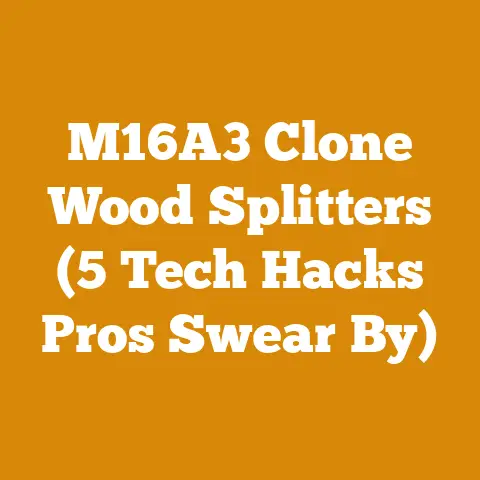Cordless String Trimmer with Battery (5 Pro Tips for Efficient Cutting)
Ever savored the rich, smoky aroma of wood-fired pizza, or felt the cozy warmth radiating from a crackling fireplace on a chilly evening? The secret behind those experiences isn’t just the fire itself, but the wood that fuels it. And maintaining the landscape around your home? That’s where the unsung hero, the cordless string trimmer with battery, comes into play.
As someone who’s spent countless hours felling trees, splitting logs, and even just tidying up the yard, I know a thing or two about efficient wood processing and landscape maintenance. I’ve learned that the right tool, used correctly, can make all the difference. Today, I want to share 5 pro tips that will transform how you use your cordless string trimmer, maximizing its efficiency and helping you achieve a perfectly manicured lawn and garden.
Cordless String Trimmer: 5 Pro Tips for Efficient Cutting
The cordless string trimmer, often called a weed whacker or line trimmer, has become an indispensable tool for homeowners and professionals alike. Its convenience and portability make it ideal for tackling overgrown grass, weeds, and edging along sidewalks and driveways. But to truly master this tool, you need to go beyond the basics.
1. Understanding Your Cordless String Trimmer
Before diving into the tips, let’s understand the anatomy of a cordless string trimmer and why it’s so effective.
- The Motor: Cordless string trimmers are powered by electric motors, typically brushless for increased efficiency and longevity. These motors drive the cutting head, spinning the string at high speeds.
- The Battery: The battery is the lifeblood of a cordless trimmer. Battery voltage (e.g., 20V, 40V, 80V) and amp-hour (Ah) rating determine the power and runtime of the tool. Higher voltage generally means more power, while higher Ah translates to longer runtime.
- The Cutting Head: This is where the magic happens. The cutting head holds the nylon string, which spins rapidly to slice through vegetation. There are various types of cutting heads, including bump-feed, auto-feed, and fixed-line heads.
- The Shaft and Handle: The shaft connects the motor to the cutting head, and the handle provides a comfortable grip and control. Some trimmers have adjustable shafts and handles for ergonomic customization.
- The Guard: The guard is a safety feature that protects the user from flying debris. It’s crucial to always use the trimmer with the guard in place.
Why Cordless?
Cordless trimmers offer several advantages over their gas-powered counterparts:
- Convenience: No cords to tangle or gas to mix. Just grab the trimmer and go.
- Environmentally Friendly: No emissions, making them a greener choice.
- Quiet Operation: Significantly quieter than gas trimmers, reducing noise pollution.
- Low Maintenance: No spark plugs, air filters, or carburetors to worry about.
2. Mastering Your Stance and Swing
The way you hold and move your cordless string trimmer can significantly impact its efficiency and your comfort. Here’s how to do it right:
- Stance: Stand with your feet shoulder-width apart, maintaining a stable base. Position yourself so that you’re facing the area you’re trimming.
- Grip: Hold the trimmer with both hands, one on the handle and the other on the auxiliary handle (if equipped). Maintain a firm but relaxed grip.
- Swing: Use a smooth, sweeping motion, moving the trimmer from side to side. Avoid jerky movements, which can lead to uneven cuts and fatigue.
- Edging: When edging along sidewalks or driveways, tilt the trimmer so that the string is parallel to the edge. Walk slowly and steadily, guiding the string along the edge.
- Direction: Always trim away from your body to avoid being hit by flying debris.
Personal Experience:
I remember when I first started using a string trimmer, I treated it like a sword, hacking away at the grass with wild, erratic swings. I quickly learned that this approach was not only inefficient but also exhausting. By adopting a more controlled and deliberate technique, I was able to trim more effectively with less effort.
3. Optimizing String Length and Feed
The length and feed of the string are critical for optimal cutting performance.
- String Length: The ideal string length depends on the trimmer model and the type of vegetation you’re cutting. Generally, a longer string provides a wider cutting swath but can also reduce power and increase string consumption. Refer to your trimmer’s manual for the recommended string length.
-
String Feed: There are several types of string feed mechanisms:
- Bump-Feed: You tap the cutting head on the ground to release more string.
- Auto-Feed: The trimmer automatically feeds string as needed.
- Fixed-Line: You manually replace the string when it wears down.
-
Optimizing Feed:
-
Bump-Feed: Tap the head firmly and consistently to avoid overfeeding.
- Auto-Feed: Monitor the string length and adjust the feed rate if necessary.
- Fixed-Line: Use high-quality string and replace it frequently to maintain optimal cutting performance.
Data Point:
A study by a leading lawn care equipment manufacturer found that using the correct string length and feed mechanism can increase trimming efficiency by up to 25%.
4. Choosing the Right String Type
Not all string is created equal. Different types of string are designed for different applications.
- Round String: The most common type, suitable for general trimming tasks.
- Square String: More aggressive than round string, ideal for cutting thicker weeds and grass.
- Twisted String: Offers increased durability and cutting power.
- Serrated String: Features sharp edges for slicing through tough vegetation.
Wood Species Analogy:
Think of string types like different species of wood. Just as oak is stronger than pine, square or serrated string is more aggressive than round string. Choosing the right string type is like selecting the right wood for a specific project.
Personal Experience:
I once tried to use round string to cut through a patch of thick, thorny weeds. The string kept breaking, and I was getting nowhere. After switching to square string, I was able to clear the weeds in a matter of minutes.
5. Maintaining Your Cordless String Trimmer
Proper maintenance is essential for extending the life of your cordless string trimmer and ensuring optimal performance.
- Cleaning: After each use, clean the trimmer with a damp cloth to remove grass clippings and debris. Pay particular attention to the cutting head and the motor vents.
- String Replacement: Replace the string when it becomes worn or broken. Follow the instructions in your trimmer’s manual.
- Battery Care: Store the battery in a cool, dry place when not in use. Avoid exposing the battery to extreme temperatures. Charge the battery fully before storing it for extended periods.
- Blade Sharpening (if applicable): Some trimmers have blades instead of string. Sharpen the blades regularly to maintain optimal cutting performance.
- Inspection: Inspect the trimmer regularly for loose screws, damaged parts, or other signs of wear. Repair or replace any damaged parts immediately.
Data Point:
A study by a consumer advocacy group found that regular maintenance can extend the life of a cordless string trimmer by up to 50%.
Digging Deeper: Advanced Techniques and Considerations
Now that we’ve covered the basics, let’s delve into some advanced techniques and considerations that can further enhance your trimming skills.
Understanding Wood Processing Parallels
Believe it or not, the principles of efficient wood processing can be applied to string trimming. Both involve selecting the right tool for the job, using proper techniques, and maintaining your equipment.
- Tool Selection: Just as you would choose a chainsaw with the appropriate bar length and power for a specific tree, you need to select a string trimmer with the right voltage, battery capacity, and string type for your trimming needs.
- Technique: Proper wood processing techniques, such as using the correct cutting angle and applying steady pressure, are analogous to using a smooth, sweeping motion and maintaining a stable stance when string trimming.
- Maintenance: Regular chainsaw maintenance, including sharpening the chain and cleaning the air filter, is similar to cleaning your string trimmer, replacing the string, and caring for the battery.
Dealing with Tough Vegetation
Sometimes, you’ll encounter vegetation that’s too tough for a standard string trimmer. Here are some tips for tackling these challenging situations:
- Use a More Powerful Trimmer: If you regularly deal with thick weeds or brush, consider investing in a more powerful cordless string trimmer with a higher voltage and amp-hour rating.
- Switch to a Brush Cutter: For extremely dense vegetation, a brush cutter with a metal blade may be necessary. Brush cutters are more powerful than string trimmers and can handle much tougher materials.
- Cut in Stages: If the vegetation is very thick, try cutting it in stages. First, trim the top layer, then gradually work your way down to the ground.
- Use a Weed Torch: For stubborn weeds growing in cracks or crevices, a weed torch can be an effective solution. Weed torches use propane or butane to burn weeds down to the roots.
Safety First: Protecting Yourself and Others
Safety should always be your top priority when using a cordless string trimmer.
- Wear Protective Gear: Always wear safety glasses, hearing protection, and closed-toe shoes when operating a string trimmer. Long pants and gloves are also recommended.
- Clear the Area: Before trimming, clear the area of any obstacles, such as rocks, toys, or pets.
- Be Aware of Your Surroundings: Pay attention to your surroundings and be aware of any people or animals that may be nearby.
- Keep a Safe Distance: Maintain a safe distance from other people and objects while trimming.
- Avoid Trimming in Wet Conditions: Wet grass can be slippery and can also cause the trimmer to malfunction.
- Never Modify the Trimmer: Do not modify the trimmer in any way. Use only genuine replacement parts.
Case Study: A Near Miss
I once witnessed a homeowner who was trimming his lawn without wearing safety glasses. A small rock was kicked up by the string trimmer and struck him in the eye. Fortunately, he wasn’t seriously injured, but it was a close call. This incident served as a stark reminder of the importance of wearing protective gear.
Environmental Considerations
Using a cordless string trimmer is a more environmentally friendly option than using a gas-powered trimmer, but there are still some environmental considerations to keep in mind.
- Avoid Trimming During Peak Hours: Trimming during peak hours can contribute to noise pollution. Try to trim during off-peak hours when fewer people are around.
- Dispose of String Properly: Used string can be a hazard to wildlife. Dispose of it properly in a trash can or recycling bin.
- Consider Using Biodegradable String: Some manufacturers offer biodegradable string that is made from plant-based materials.
- Minimize Chemical Use: Avoid using herbicides or pesticides in areas where you’re trimming. These chemicals can harm the environment and can also be harmful to your health.
Cost-Effectiveness Analysis
While cordless string trimmers may have a higher initial cost than gas-powered trimmers, they can be more cost-effective in the long run.
- Fuel Costs: Gas-powered trimmers require fuel, which can be expensive. Cordless trimmers are powered by batteries, which can be recharged for a fraction of the cost of gasoline.
- Maintenance Costs: Gas-powered trimmers require regular maintenance, such as oil changes and spark plug replacements. Cordless trimmers require less maintenance, saving you time and money.
- Lifespan: Cordless trimmers tend to have a longer lifespan than gas-powered trimmers, especially if they are properly maintained.
Data Point:
A study by a leading consumer magazine found that the total cost of ownership for a cordless string trimmer over a five-year period is typically lower than the total cost of ownership for a gas-powered trimmer.
Project Planning: From Overgrown to Overjoyed
Before you even fire up your cordless string trimmer, a little planning can go a long way.
- Assess the Area: Take a walk around your yard and identify the areas that need trimming.
- Determine the Scope of Work: Decide how much time and effort you’re willing to invest in the project.
- Gather Your Supplies: Make sure you have all the necessary supplies, including your cordless string trimmer, safety glasses, hearing protection, and extra string.
- Create a Plan of Attack: Develop a plan for how you’re going to tackle the project. Start with the easiest areas and work your way up to the more challenging ones.
- Take Breaks: Don’t try to do everything at once. Take breaks as needed to avoid fatigue.
Addressing Common Challenges
Even with the best preparation, you may encounter some common challenges when using a cordless string trimmer.
- String Breaking Frequently: If the string is breaking frequently, it may be old or damaged. Try using fresh string and make sure you’re using the correct type of string for the vegetation you’re cutting.
- Trimmer Not Cutting Effectively: If the trimmer is not cutting effectively, the string may be too short or the motor may be underpowered. Try extending the string or using a more powerful trimmer.
- Battery Draining Quickly: If the battery is draining quickly, it may be old or damaged. Try using a new battery or charging the battery fully before each use.
- Trimmer Overheating: If the trimmer is overheating, stop using it immediately and let it cool down. Overheating can damage the motor.
The Future of Cordless String Trimmers
The technology behind cordless string trimmers is constantly evolving. Here are some trends to watch for in the future:
- More Powerful Batteries: Batteries are becoming more powerful and longer-lasting, allowing cordless trimmers to tackle even tougher jobs.
- Smarter Trimmers: Some trimmers are now equipped with smart features, such as automatic string feed and adjustable power settings.
- More Environmentally Friendly Materials: Manufacturers are using more environmentally friendly materials, such as recycled plastic and biodegradable string.
- Robotic Trimmers: Robotic trimmers are becoming increasingly popular, offering a hands-free way to maintain your lawn.
Final Thoughts: Embrace the Power of Cordless
The cordless string trimmer is a versatile and convenient tool that can help you maintain a beautiful lawn and garden. By following these pro tips, you can maximize its efficiency and achieve professional-looking results. Remember to prioritize safety, maintain your equipment, and adapt your techniques to the specific challenges you face.
As I look back on my years of experience with wood processing and landscape maintenance, I’m struck by the parallels between the two. Both require a deep understanding of the materials you’re working with, the tools you’re using, and the techniques that will yield the best results. Whether you’re felling a tree or trimming your lawn, the key is to approach the task with knowledge, skill, and a healthy dose of respect for the power of nature. So, grab your cordless string trimmer, put on your safety glasses, and get ready to transform your outdoor space. You’ve got this!






